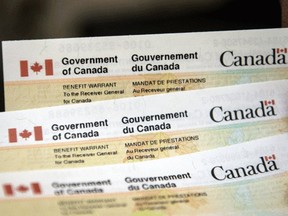Case appears to be the first ruling on a grievance filed by a bureaucrat who opposed their firing for improperly receiving CERB

Article content
OTTAWA — If you were a public servant working for the federal department responsible for CERB, you shouldn’t have applied for the $2,000-per-month pandemic benefit — seven times.
That’s a lesson that Jacqueline Byrne, a former Service Canada benefits officer at Employment and Social Development Canada (ESDC), learned the hard way from a federal labour relations board.
Advertisement 2
Article content
In a ruling earlier this year, the Federal Public Service Labour Relations and Employment Board (FPSLREB) confirmed that the government was right to revoke Byrne’s security clearance — effectively firing her — after she received $14,000 in Canada Emergency Response Benefit (CERB) payments.
Byrne’s case appears to be the first ruling on a grievance filed by a bureaucrat opposing their firing for receiving CERB while working in the public service.
In a statement provided by her lawyer, Byrne said the decision was “very disappointing” and failed to consider the hectic and confusing atmosphere early in the pandemic.
“The CERB was rolled out very quickly and many people were confused about it, including myself. I was also living through a terrible time with the deaths of both of my parents during the pandemic. This was the worst time of my life and I feel like ESDC and the Board didn’t have any empathy for my situation whatsoever,” she wrote.
When the pandemic began in 2020, Byrne was working full-time for the department that was responsible for CERB. In fact, Byrne’s job as an “experienced” benefits officer was to ascertain applicants’ eligibility for Employment Insurance, the ruling says.
Article content
Advertisement 3
Article content
And yet, Byrne told the tribunal that she applied for CERB seven times in a row starting on March 15, 2020, because she apparently misunderstood the program’s “confusing” eligibility criteria.
While the program was designed for individuals who lost virtually all their income due to COVID-19 lockdowns, she said she thought it was available to people who lost their job or their self-employment income.
Recommended from Editorial
Byrne had started a small home crafts business in 2019, the ruling says, and she thought that the pandemic would cut into her projected earnings for 2020. Based on that assumption, the full-time public servant applied repeatedly for CERB, netting $14,000 in payments from the self-attestation-based program.
Not only was Byrne not eligible for CERB because she worked full time for the government, but her craft business income actually grew that year, wrote labour board member Nancy Rosenberg.
Advertisement 4
Article content
“By the May 24 weekend she knew, or should have known, that she had not lost any self-employment income. In fact, May was the month that her home business income was slightly over the $1,000 limit, making her ineligible for the CERB even without considering her employment income,” Rosenberg wrote.
The ruling notes that Byrne appeared to have doubts about her eligibility and called the Canada Revenue Agency helpline — twice — to check.
She said the agents advised that she might be eligible for CERB because she claimed to have lost her self-employment income and that if she wasn’t, she would just have to pay the money back.
But Rosenberg said the “uncurious” Byrne gave only the information that she thought would lead to the answers she wanted to hear and “maintain plausible deniability.”
She also noted Byrne was far from forthcoming on the call. She “misled” the agent, omitted to say who she was or that she worked for ESDC and falsely claimed that she had lost her craft business income, according to the decision.
“The grievor suspected that she was not eligible for the CERB but kept herself wilfully blind to that likely possibility,” Rosenberg wrote.
Advertisement 5
Article content
“If she really wanted to know, she would have approached the CRA inquiries line straightforwardly and identified herself and her continuing full-time federal government employment. She certainly would not have said that she had lost her self-employment income, because that was not true.”
During the hearings, Byrne said her confusion was due to CERB’s original attestation statement asking “you have either stopped or will stop working due to COVID 19, or, You have lost or will lose your regular employment or self-employment income,” the ruling notes.
But just over a month after launch, the government clarified that applicants had to have lost all their monthly income worth over a combined $1,000 to apply.
Still, Byrne kept applying and attesting she was eligible, the ruling reads.
“She explained that she did not really listen to the questions, that she ‘rushed through’ both the questions and the read-back and verification of her answers. She likened it to the process of some EI claimants, including herself, who just remember the order of yes/no questions and answer by rote, without actually considering the questions at all,” Rosenberg wrote.
Advertisement 6
Article content
“This testimony was problematic on several levels,” she added.
After launching an investigation into Byrne, ESDC ultimately concluded that she had committed a breach of confidence. The department investigator also said that Byrne gave him “misleading information.”
During the tribunal hearings, ESDC argued that Byrne’s conduct was “fraud” while she admitted to “bad judgment” but argued that the worst she could be criticized for was “wishful thinking.”
She also argued that CERB’s eligibility criteria were “confusing for everyone” and the wording was ambiguous and changed over time.
Byrne also asked that the labour board consider that 2020 was an “extremely difficult and stressful time” for her as her mother and father both fell seriously ill and required her care.
But that explanation did not move the tribunal.
“While I have no doubt that she may not have been at her best during that stressful time, I cannot accept that her actions can be attributed to the medical crises that her family members were experiencing,” Rosenberg wrote.
“She worked full-time for ESDC, took no leave during that time, volunteered for a significant amount of overtime and continued to grow her home business. The grievor, while undoubtedly severely stressed, seems to have been functioning reasonably well.”
Advertisement 7
Article content
Rosenberg also found that after she was fired from ESDC, Byrne lied on her application for a job to the CRA when she reported on a form that she had not previously completed a government security screening form.
“I find that she answered no to that question in order to conceal the revocation of her reliability status and termination from her ESDC employment,” Rosenberg wrote.
Byrne’s lawyer, Paul Champ, said Byrne no longer works for the CRA.
In a statement, ESDC spokesperson Liana Brault said that 56 department employees had been terminated for claiming and receiving COVID-19 benefit payments while being ineligible.
In September, National Post reported 289 Canada Revenue Agency workers were fired or had resigned for that reason.
National Post
cnardi@postmedia.com
Get more deep-dive National Post political coverage and analysis in your inbox with the Political Hack newsletter, where Ottawa bureau chief Stuart Thomson and political analyst Tasha Kheiriddin get at what’s really going on behind the scenes on Parliament Hill every Wednesday and Friday, exclusively for subscribers. Sign up here.
Our website is the place for the latest breaking news, exclusive scoops, longreads and provocative commentary. Please bookmark nationalpost.com and sign up for our politics newsletter, First Reading, here.
Our website is the place for the latest breaking news, exclusive scoops, longreads and provocative commentary. Please bookmark nationalpost.com and sign up for our daily newsletter, Posted, here.
Article content





